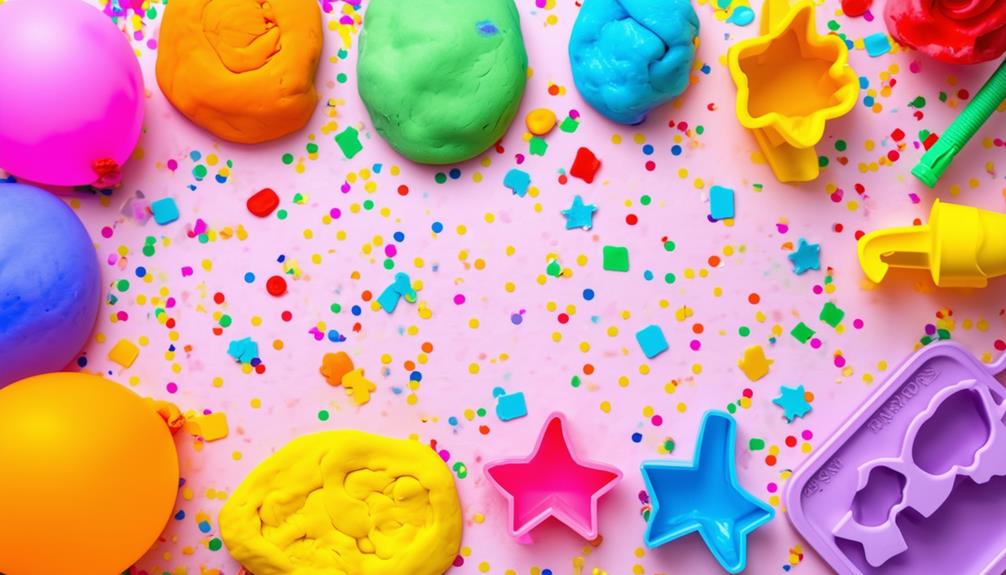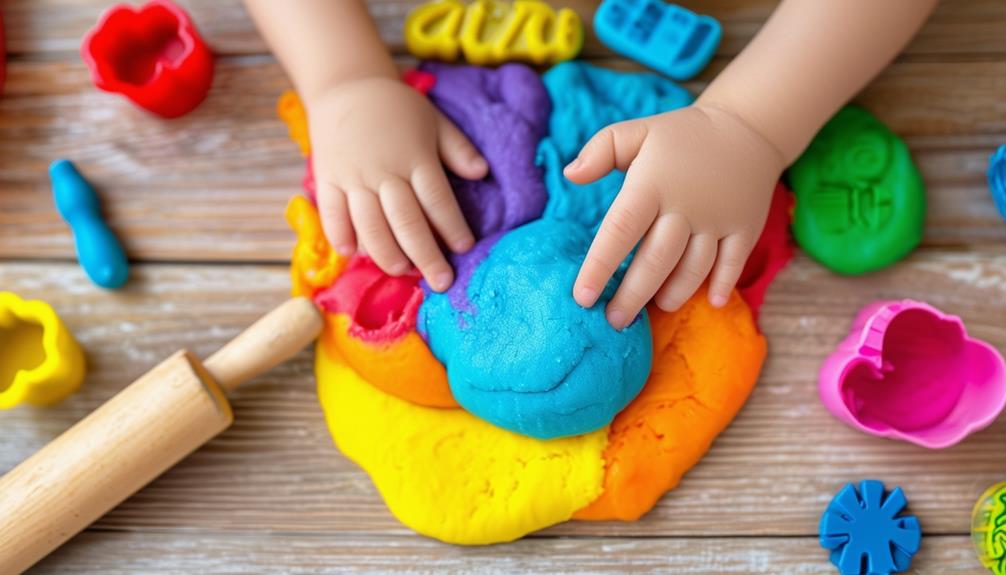10 Playdough Crafts to Boost Your Child's Creativity

If you're looking to spark your child's imagination, these 10 playdough crafts offer a variety of ways to do just that. From crafting fanciful animals and colorful flowers to designing unique jewelry and imaginative monsters, each activity provides a fun, hands-on learning experience. Not only do these crafts engage your child's creativity, but they also help develop fine motor skills and hand-eye coordination. Curious how playdough can be both educational and fun? Discover how these simple activities can transform regular playtime into an enriching experience for your child.
Playdough Animals
Creating playdough animals is a fun and educational activity that stimulates your child's imagination and creativity. By molding various shapes and colors, your child learns about different animal species while also enhancing their fine motor skills. The process of shaping playdough requires precision and coordination, which helps develop small hand muscles and improves hand-eye coordination.
Crafting playdough animals naturally encourages imaginative play. Your child can create stories where their playdough creatures embark on exciting adventures. This type of play fosters innovative thinking and imagination, essential for cognitive development. They will enjoy creating a zoo filled with vibrant animals, each with unique characteristics and names.
Playdough animals also offer educational benefits. While your child shapes a lion, elephant, or bird, you can teach them the animal's name, habitat, and traits. This hands-on learning makes the information more engaging and memorable. Additionally, encouraging your child to describe their playdough creations enhances their vocabulary and storytelling skills.
Incorporating these activities into your daily routine will help your child's creativity and fine motor skills flourish while they enjoy imaginative play.
Playdough Flowers
Let's start crafting beautiful petals using playdough. Encourage your child to explore various flower designs, experimenting with different shapes and sizes. Together, brainstorm fun flower arrangement ideas, transforming playtime into a creative adventure.
Crafting Blooming Petals
Dive into the world of playdough flowers by shaping petals, stems, and leaves to create your own blooming masterpieces. This hands-on activity not only sparks creativity but also helps children develop fine motor skills. By manipulating the playdough to form intricate petals and detailed leaves, children can express their artistic abilities while exploring nature's beauty.
Begin by rolling playdough into small balls and flattening them to create petals. Encourage varying sizes and textures to make the flowers more authentic. Form the stems by rolling the playdough into thin, elongated shapes, and add leaves by molding small, flattened pieces and attaching them to the stems.
Let children experiment with different flower types, from daisies to roses, fostering endless creativity and imagination. By adding details like veining on leaves or layering petals, they can enhance the realism and engagement of their playdough flowers.
Crafting blooming petals with playdough offers a delightful way for children to connect with nature and develop their artistic skills. It's a perfect blend of fun and learning that keeps their creativity flourishing.
Colorful Flower Designs
Having mastered the art of crafting blooming petals, it's time to delve into the vibrant world of colorful flower designs with playdough. This hands-on activity is ideal for kids to learn about color mixing and enhance their fine motor skills.
Start by allowing your child to choose a few playdough colors. Encourage them to mix and match to create unique shades for their flowers, enriching their sensory play and sparking their creativity.
Guide your child in shaping petals, stems, and leaves, each element requiring a different technique. Rolling, flattening, and pinching the playdough are excellent exercises for little hands, enhancing their fine motor skills.
As they build their colorful flower designs, encourage their imagination. Playdough flower crafts foster imaginative play and artistic expression, allowing kids to experiment with shapes, sizes, design, and symmetry.
This activity is both fun and educational. Through sensory play, children can learn about different flower types and basic plant anatomy, while boosting their creativity and motor skills. Dive into playdough flower crafting and watch your child's skills blossom!
Flower Arrangement Ideas
Creating playdough flower arrangements is a delightful way for children to combine creativity and fine motor skills. These hands-on activities allow kids to express themselves artistically while practicing hand-eye coordination. Start by having your child roll out different colors of playdough to form petals, leaves, and stems. Encourage them to experiment with diverse shapes and sizes to spark creativity and inspire unique designs.
Introduce your child to the concept of flower arrangements by showing them how to group their playdough flowers into bouquets or simple displays. This not only makes for a fun art project but also enriches their understanding of balance and composition. Playdough flowers offer a mess-free and non-permanent alternative to real flowers, making them perfect for imaginative play and sensory exploration.
For added creativity, suggest mixing in other craft materials like beads or buttons as flower centers. This combination of textures can make the activity even more engaging. Ultimately, playdough flower arrangements serve as a wonderful way to elevate your child's creative skills and provide hours of enjoyable, educational play.
Playdough Food

Encourage your child's creativity with playdough food creations like pizzas and other pretend kitchen items. This activity enhances fine motor skills and fosters imaginative play and storytelling. Through shaping various food items, your child also learns about different shapes, colors, and textures.
Playdough Pizza Creations
Transform your child's playtime into a culinary adventure with playdough pizza creations. Here, they can roll out dough, add toppings, and craft their own imaginative dishes. This activity combines pretend play with hands-on learning, allowing kids to explore food and cooking concepts in a fun, interactive way. They'll enjoy designing unique pizza masterpieces with playdough cheese, veggies, and other toppings.
Engaging in playdough pizza creations promotes fine motor skills and creativity. As your child rolls out the dough and arranges toppings, they're not just having fun—they're also honing hand-eye coordination and dexterity. Additionally, this activity can spark conversations about healthy eating habits, making it both educational and entertaining.
To get the most out of playdough pizza-making, consider these tips:
- Texture Variety: Use different colors and textures of playdough to represent various toppings, enhancing the sensory experience.
- Role-Playing: Encourage your child to take on roles like chef or customer, enriching their social interaction and language skills.
- Healthy Conversations: Discuss the benefits of different food groups as they create their pizzas, subtly teaching them about nutrition.
With playdough pizza creations, your child's imagination is the limit!
Pretend Play Kitchen Fun
After making delightful playdough pizzas, your child can expand their culinary adventures with a full pretend play kitchen, crafting burgers, ice cream, and more. These activities are not only entertaining but also excellent for nurturing creativity and imagination. When your child molds and shapes different food items, they are engaging in both play and learning.
Creating playdough food helps develop fine motor skills and hand-eye coordination. Rolling out dough, forming patties, and scooping 'ice cream' require precise movements that enhance these essential skills. Additionally, the sensory-rich experience of touching and manipulating various textures and shapes adds an educational dimension to the play.
Pretend play in a kitchen setting also promotes social interaction. Your child can assume different roles, such as a chef or a customer, encouraging conversations and collaborative play with siblings or friends. This type of role-playing fosters communication skills and helps children understand diverse perspectives.
Playdough Jewelry
Creating playdough jewelry is a fun and educational activity for kids, allowing them to design unique accessories while developing fine motor skills. By shaping and decorating beads and charms, children enhance their dexterity and hand-eye coordination.
This activity also fosters imaginative play, encouraging kids to customize their jewelry with beads, glitter, and other embellishments. They can experiment with various colors and textures, expressing their personal style.
To maximize the benefits of this activity, consider the following tips:
- Gather Supplies: Provide a variety of colorful playdough, beads, glitter, and string. This enables your child to explore different combinations and designs.
- Demonstrate Techniques: Show your child how to roll playdough into beads or shape it into charms. Encourage them to try new methods and see what they can create.
- Create Together: Spend time making playdough jewelry alongside your child. This shared activity fosters bonding and mutual creativity.
Playdough Monsters
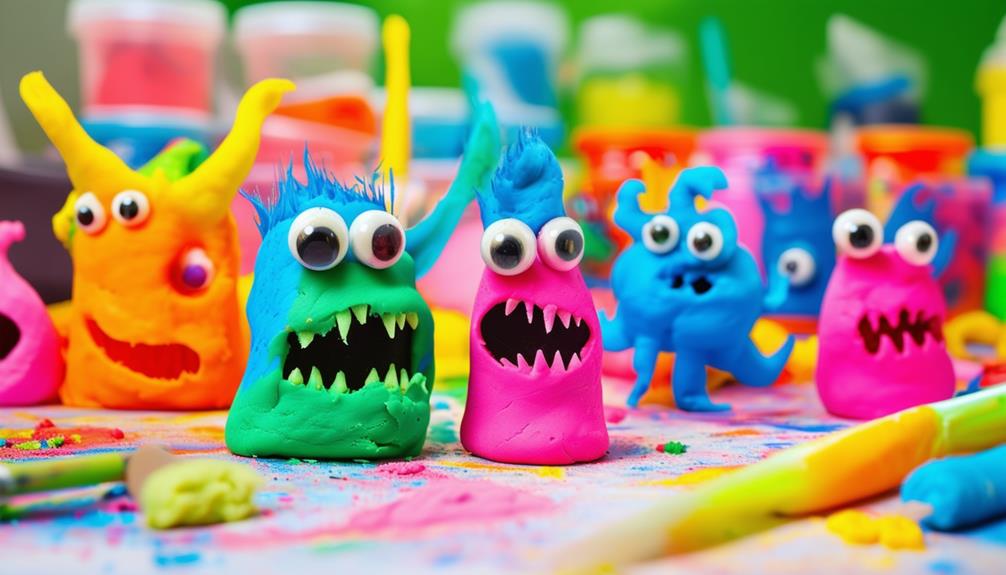
Encourage your child to unleash their creativity by crafting Playdough Monsters using vibrant colors and unique features. They'll enjoy designing creatures with multiple eyes, funny mouths, and quirky shapes. This activity not only fosters creativity but also enhances fine motor skills and storytelling abilities.
Imaginative Creature Designs
Creating playdough monsters is an excellent way for your child to unleash their creativity while honing essential skills. This imaginative activity not only entertains but also enhances fine motor skills and hand-eye coordination. As children mold and shape the playdough, they engage with various textures and forms, making the experience both educational and fun.
Encourage your kids to think outside the box and create their own unique playdough monsters. They can design creatures with multiple eyes, long tentacles, or even funny hats. The possibilities are endless, and each new creation demonstrates their growing creativity and problem-solving skills.
To help your child get the most out of their playdough monster crafting, consider these tips:
- Story Development: Encourage your child to create a backstory for their monster. This adds a storytelling dimension and enriches their imaginative play.
- Shape Experimentation: Motivate them to experiment with different shapes and features to see what unique creatures they can come up with.
- Interactive Play: Invite friends or siblings to join in. Collaborative play can lead to even more creative designs and greater enjoyment.
Colorful Monster Features
Add a splash of color to your child's playdough monsters with vibrant features like eyes, horns, and tails. Using homemade play dough, create a variety of colorful elements to transform simple shapes into imaginative creatures. This activity encourages imaginative play and engages your child's creativity as they design unique monsters.
Adding these colorful features helps develop fine motor skills. When your child molds tiny eyes, twists horns, or rolls out tails, they enhance their hand-eye coordination and dexterity. The different textures and shapes also provide a sensory-rich experience, making the activity even more enjoyable.
Encourage your child to mix and match colors for their monster features. They might create a monster with bright red eyes, blue horns, and a green tail. This customization deepens their engagement and prompts creative thinking. It's a fantastic way to spend quality time together, fostering creativity and storytelling. With homemade play dough, the options are endless, offering hours of fun crafting unique playdough monsters.
Playdough Scenery
Creating playdough landscapes allows your child to design small-scale scenes such as forests, beaches, or gardens, igniting their imagination and storytelling abilities. This imaginative play captivates their creative minds and promotes the development of fine motor skills. As they shape trees, mold waves, or craft flowers, they're practicing precise hand movements that enhance dexterity and coordination.
Incorporate natural components like sticks, rocks, or leaves to add authenticity to the playdough scenery. This hands-on crafting process cultivates spatial awareness, helping your child understand how different elements fit together within a landscape. By engaging in this activity, your child can explore diverse themes or educational topics, making the experience both enjoyable and informative.
To maximize the potential of playdough scenery, consider these suggestions:
- Theme Selection: Choose a theme such as a tropical beach or enchanted forest to guide the creation process and maintain focus on the activity.
- Natural Elements: Use materials like pebbles, twigs, and leaves to introduce texture and realism to the scenery.
- Storytelling: Encourage your child to invent stories about their miniature landscapes, enriching their narrative skills.
Immerse yourself in the world of playdough landscapes and watch your child's creativity flourish.
Playdough Vehicles
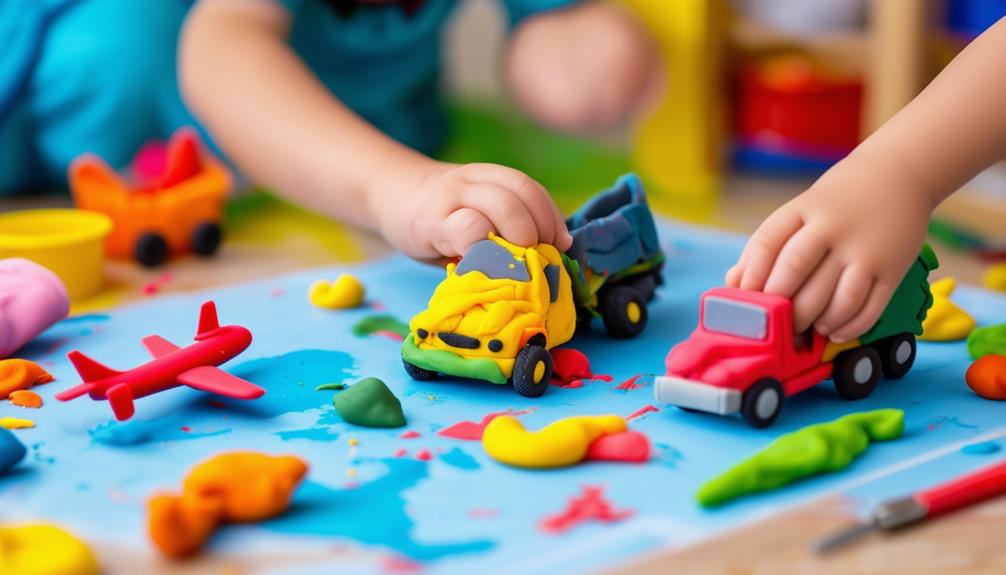
Playdough vehicles offer an exciting way for your child to engage their imagination and fine motor skills. Using various colors and shapes, your child can create unique cars, trucks, planes, and more. This hands-on activity captivates their creativity and enhances their hand-eye coordination.
Crafting playdough vehicles nurtures innovative thinking and problem-solving. As they experiment with different designs, they develop problem-solving skills and make decisions about structure and stability. The endless possibilities of playdough vehicles ensure hours of creative play, allowing your child to build and rearrange their creations.
Encourage your child's imagination by mixing and matching colors to create unique vehicles. Whether constructing a speedy race car or a soaring aircraft, shaping and assembling playdough vehicles is both fun and educational. This activity not only entertains but also supports cognitive and developmental growth. So, bring out the playdough and watch your child's creativity take flight with their personalized vehicles.
Playdough Abstract Art
Playdough abstract art offers a creative platform for children to explore shapes, colors, and textures freely. This art form encourages them to experiment without the pressure of creating something recognizable, fostering their unique style and interpretation of the world. By using various tools and techniques, children can produce imaginative, one-of-a-kind pieces.
This activity not only sparks creativity but also enhances fine motor skills and hand-eye coordination. Manipulating playdough requires precise hand and finger movements, which strengthen dexterity. Additionally, the sensory-rich nature of playdough engages multiple senses, providing a holistic creative experience.
To maximize the benefits of playdough abstract art, consider these tips:
- Provide a variety of tools: Offer different shaping tools, stamps, and textures to inspire diverse creations.
- Encourage open-ended experimentation: Allow your child to mix colors and shapes without specific goals.
- Display their artwork: Showcasing their creations boosts confidence and celebrates their creativity.
These steps will ensure your child enjoys a fulfilling and enriching creative process.
Playdough Letters
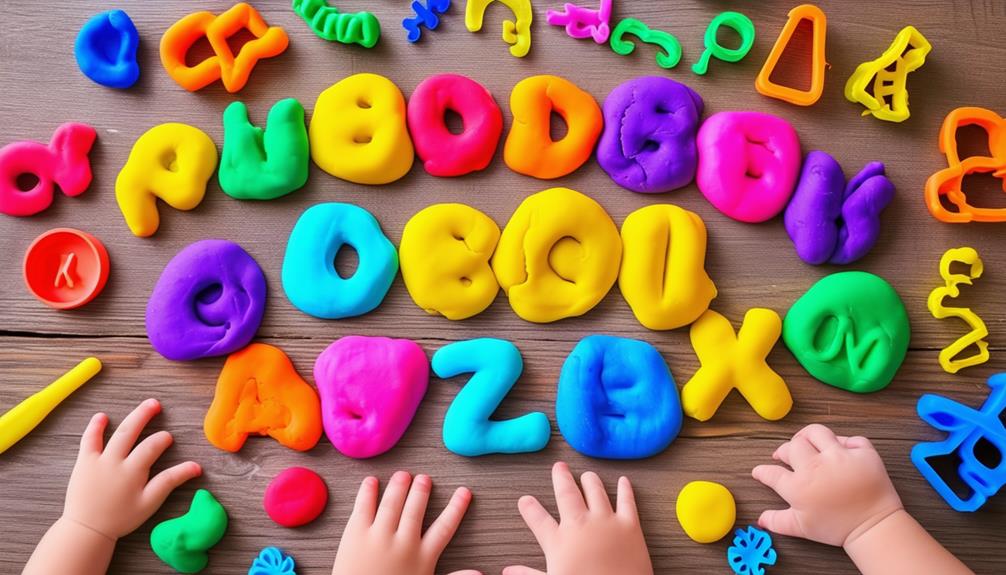
Engaging in the activity of molding playdough letters allows your child to develop essential literacy skills while having fun. This hands-on method teaches letter recognition and formation, enhancing fine motor skills and hand-eye coordination necessary for writing.
Playdough offers a rich sensory experience that engages multiple senses, making learning interactive and memorable. The tactile sensations of rolling, pressing, and molding help reinforce letter shapes in your child's mind, integrating touch and sight for a full-body learning experience.
Additionally, playdough letters create opportunities for practicing spelling, sight words, and phonics. Your child can spell their name, simple words, or even short sentences, making learning both dynamic and enjoyable. This activity fosters creativity while building a strong foundation for language and literacy concepts.
Incorporating playdough letters into your child's routine transforms a simple craft into an educational adventure. This playful approach keeps your child engaged and excited about learning, all while developing essential skills in a fun and interactive environment.
Playdough Numbers
Molding playdough numbers allows your child to improve their numerical recognition skills while having fun. This engaging activity not only aids in learning numbers but also strengthens fine motor skills. By shaping playdough into various numerals, kids can practice counting and familiarize themselves with number formation, making math feel like a playful endeavor rather than a chore.
You can easily make homemade playdough using simple ingredients like flour, salt, water, and food coloring. This adds an extra layer of fun and creativity, as your child can choose their favorite colors and textures. Plus, it's a fantastic way to involve them in the process from start to finish.
Here are three ideas to enrich your playdough numbers activity:
- Colorful Numbers: Encourage your child to make each number in a different hue to help with color recognition and make the activity more visually stimulating.
- Number Sequencing: Create a game where your child places the molded numbers in the correct order, reinforcing their counting skills.
- Textured Digits: Add elements like glitter or sand to the playdough to make the numbers more tactile and engaging.
These activities not only promote learning but also stimulate creativity through sensory play.

